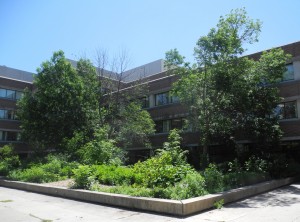by Michael Classens
You might call the HNES Native Species Garden a campus naturalization project—designed to make the campus more ‘natural’. The corollary to this, of course, is that the campus is too ‘unnatural’. And I have to admit, the tactile contrast between the concrete campus surrounding the HNES garden, and the soft mulch within it, is stark. My feet unanimously prefer the latter. Yet this is only the start of the incongruousness between the garden and the campus beyond. What I see, smell and feel is all noticeably different inside the garden than beyond its borders. Outside the garden I see mostly buildings and turf grass, within it, there are dozens of native species of plants, flowers, shrubs, grasses, a few trees, and even a couple of groundhogs. And then, as though purposefully spoiling the tidy conceptual and sensorial division between the ‘natural’ garden and the ‘unnatural’ campus, I see a duck waddling down a campus sidewalk.
If the campus is so ‘unnatural’, this duck didn’t get the memo. Come to think of it, maybe the garden isn’t as ‘natural’ as I first thought either. Lessons from scholars who urge us to question the seemingly sacrosanct distinction between ‘natural’ and ‘social’ things suddenly swirl through my mind. The garden was built (I use that word deliberately) in 2005. Dr. Gerda Wekerle led the project, and had lots of help from other Environmental Studies faculty members and students, and from York University’s grounds maintenance staff. I look around the garden, and with the help of the hand written signs, see elderberry bushes, lobelia, Canadian columbine, witch hazel, cardinal plant and pagoda dogwoods. Yes, these seem to be ‘natural’ things, but none of these plants would be where they are, here in this garden, without the herculean effort of Dr. Wekerle and her team who organized, agitated, raised funds, bought and transported plants, arranged them just so, dug holes, planted and watered. In other words, without all of this social work, the ‘natural’ garden wouldn’t, indeed couldn’t, exist. And in a similar, but opposite way, the concrete of the campus seems resolutely social in character. It’s the stuff of sky scrapers and roads, campus buildings and curbs. But it’s also just rock and water, reconstituted into different shapes and configurations, in ways very similar to how the HNES Native Species Garden was deliberately designed and manufactured.

The HNES Native Species Garden is all but natural. There is not only human labour expended on planting and maintaining the garden as “native,” but the garden itself is resting on a bed of concrete, itself made of natural material, that covers a two-level basement of classrooms and offices. The photo is taken from the Ross Building showing the almost-finished construction of the HNES Building and the “garden” in the middle of the image. Photo courtesy Clara Thomas Archives and Special Collection, York University.
Another reason why the staff, students and faculty members at York wanted to build the garden, as its name suggests, was to protect native species biodiversity. Biologists point out that native species of plants, and even animals, are continually under threat by non-native, exotic and invasive species. Certainly the omnipresent turf grass beyond the garden is an invasive species, and would take over the garden if not for the small but dedicated group of students and faculty who regularly ensure that any sprouting grass is summarily plucked out. But I can’t help but think that the concrete seems every bit the invasive species the grass is. Sure, concrete ‘grows’ through different kinds of processes than grass does, but grow it certainly does. As if to put a fine point on this latter thought, a bobcat carrying a load of crushed stone races by the garden, destined for one of the many active construction sites on campus.
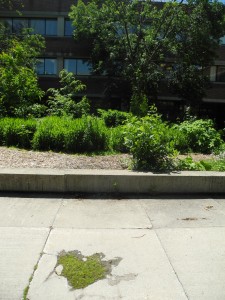
A patch of grass takes hold in a hole in the concrete just beyond the border of the HNES Native Species Garden. Students and faculty commit many hours of labour every spring and summer removing turf grass from the garden, in order to maintain its integrity as a place only for native species. Is this patch of grass making its way toward the garden? Does nature express autonomy and will? Photo courtesy L. Anders Sandberg.
Thinking a little more about this admittedly cagey idea that the distinctions between nature and society aren’t as certain as I once believed them to be, leads me to reflect on the implications of the garden being for ‘native’ species only. Despite the fact that turf grass is commonplace nowadays, it’s not allowed in the garden. Similarly, ‘exotic’ species ‘not from here’ aren’t welcome in the garden either. I recall an article in which Larson (2005) demonstrates that the language of ‘invasion biology’ draws on many violent and militaristic metaphors, which in addition to being largely inaccurate from a plant science perspective, also can lead to social misunderstandings and even xenophobia. I also think about another article by Foster and Sandberg (2004) who reveal that naturalization projects, not unlike the HNES Native Species Garden, tend to benefit wealthy communities instead of marginalized or poor ones. Is it possible that the garden I’m standing in is subtly reproducing unwanted racial and class dynamics? If the distinction between ‘natural’ things and ‘social’ things isn’t as absolute as I previously thought, and if this garden is only for ‘native species’, is it possible that this garden is racist?

The foamflower, Tiarella cordifolia, an “Ontario native”, carefully planted and labeled in the native species garden. Are exotic species introduced by First Nations peoples in southern Ontario in the pre-European contact period invasives? Who determines what constitutes an Ontario native species? Why do some people get to determine this over others? Photo courtesy L. Anders Sandberg.
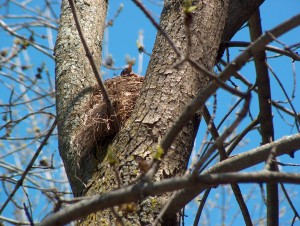
Birds thrive in the Native species garden. This nest was placed in one of the ashes in the garden infested with the Emerald Ash Borer, Agrilus planipennis, an invasive insect species from China and eastern Asia. Perhaps the nestlings were fed some of these borers. The ash has since been removed to prevent the spread of the borer to neighbouring trees. Is the labeling of the ash borer as invasive and the attempts to eradicate it the right strategy to deal with its presence? Or, should we consider the ash borer as part of us and learn how to live with it? Photo courtesy L. Anders Sandberg.
I’m suddenly struck by the urge to leave the garden, and jump briskly out of it. Just to my right, I see a stand of Japanese Flowering Cherry trees, a dozen or so meters away from the garden. In the spring these trees, along with close to 250 others peppered across campus, are unmistakeable. The brilliant and abundant pinkish-white flowers on each tree makes them look like giant cones of cotton candy with oversize tree trunk handles. The trees were given to York University by the Consulate-General of Japan to celebrate the close ties between the government of Japan and Canada—particularly those between Japan and York University. So the trees aren’t ‘from around here’. But they’ve come here to celebrate the close cultural and social ties between two very different places. Yet as aesthetically pleasing and culturally significant as these trees are, they likely wouldn’t be allowed in the garden, because the trees aren’t ‘native’ to Canada. The same is true for the Norwegian Maples that stand on guard for the Native Species Garden at the perimeter of the concrete that surround the garden. The Norway Maple was introduced to Canada in the mid-nineteenth century and has since become a beloved and common urban tree species. Given its long-standing status in Canada, should it, as Brendon Larson (2015) argues, be given Canadian citizenship and also be invited in the Native Species Garden?
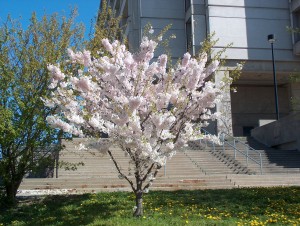
One of the many Japanese Cherry trees on campus blooming at the south end of the Ross Building a stone’s away from the HNES Native Species garden. The tree celebrates the friendship between Canada and Japan and has adjusted well to Canadian environmental conditions. While an exotic, it is not an invasive that threatens native species. Given its benign presence, why isn’t the Japanese Cherry tree welcome in the Native Species garden? Photo courtesy L. Anders Sandberg.
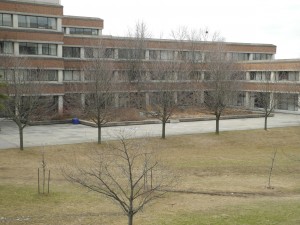
Several Norway Maples line precariously the perimeter of the concrete that encircle the HNES Native Species Garden. Will the maples be invited into the Native Species Garden one day? Photo courtesy L. Anders Sandberg.
This thought makes me a little melancholic, and in what I imagine to be a mission of goodwill, I walk over to the Japanese Flowering Cherry trees, and lay in their shade. As I unexpectedly drift off to sleep, I dream that the plants in the HNES Native Species Garden invite the Japanese Flowering Cherry trees, the Norway Maples, and I into the garden for a multi-cultural celebration. And as we all sip on the elderberry wine Dr. Gerda Wekerle once made from the berries she harvested from the garden, the ‘exotic’ cherry trees, the ‘native’ species, and the ‘human’ me talk about biodiversity and cultural diversity, inclusion and exclusion, and nature and society.
The stories of and around the HNES Native Species Garden open up several questions, including:
- To what extent are ‘natural’ landscapes ‘social’?
- To what extent are ‘social’ landscapes ‘natural’?
- Are landscapes political?
- How can we maintain bioregional biodiversity while fostering sociocultural diversity?
- Can you think of of a time when you have experienced the ‘social’ and ‘natural’ worlds coming together?
References
- Foster, J, Sandberg, LA (2004) Friends or foe? Invasive species and public green space in Toronto. Geographical Rev. 94(2): 178-198.
- Larson, B (2015) Seeking Citizenship: The Norway Maple in Canada. In Sandberg, LA, A Bardekjian and S Butt, editors, Urban Trees, Forests and Greenspace: A Political Ecology Perspective (London: Earthscan/Routledge), 176-190.
- Larson B (2008) Friend, foe, wonder, peril. Alternatives J.34(1):14-17.
Biography
I’m a PhD student in the Faculty of Environmental Studies. I study capitalist nature, political ecology and the socio-natural dynamics of agriculture. Dr. Gerda Wekerle is my supervisor, but I never did get any of that elderberry wine. I think a lot about how nature and society are tangled up together, and confess to being confused a lot of the time. I love walking down Toronto alleys as much as I love waking up in the back country of Algonquin park. Both are infinitely better with a cup of coffee in hand. My partner Serena and I have a dog named Sue.

This work is licensed under a Creative Commons Attribution-ShareAlike 3.0 Unported License.



